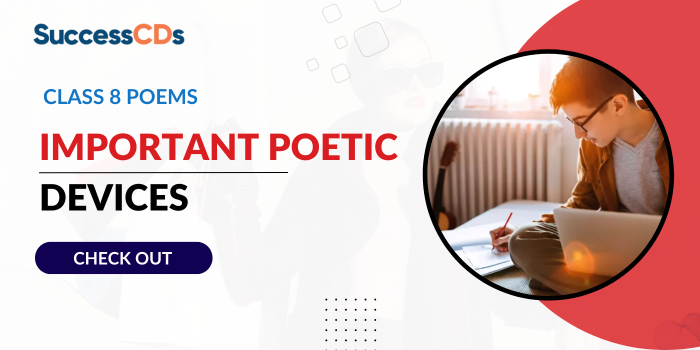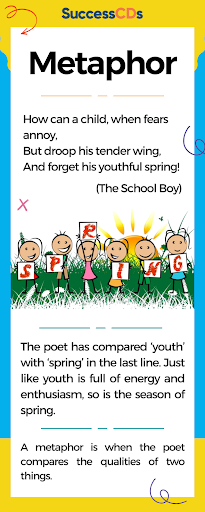
List of Important Poetic Devices for Class 8 English Poems
Do you want to know about Important Poetic devices for Class 8 English Poems. It is important to know the meaning of a poetic device so that you get to understand a poem. Poets use many techniques which are also known as figures of speech. The knowledge of these literary devices is very crucial for examination because you may get a question based on these poetic devices.
First of all, let us understand what does the term – poetic devices mean-
What are Poetic Devices?
Poetry uses literary devices known as poetic devices. The tools poets employ to make their poetry interesting are known as poetic devices.They deepen the poem’s message and meaning and emphasise its rhythmic charm. Poems frequently employ key poetic devices that delicately shift the mood and emotion of the readers. The main idea is to create a musical effect, rhyme, develop a story, etc. These poetic devices make poetry unique and differentiate it from other forms of written text.
Poetic devices are a subcategory of literary devices. That is why, all poetic devices are literary devices but not all literary devices are poetic devices.
It would be impossible to compile an exhaustive list of all poetic devices in this article. Instead, we will look at a few commonly used poetic devices and also highlight their use in poems prescribed in Class-8 CBSE syllabus.
Let’s have a look at some of the most important poetic devices used in class 8 poems.
1. Alliteration
Alliteration is the repetition of a consonant sound at the beginning of multiple words in a series.
Example-
Through the warm, sunny months of gay summer and spring,
(The Ant and the Cricket)
He held my hand and said,
(The Last Bargain)
2. Enjambment
An enjambment is the continuation of a sentence beyond a line break, couplet, or stanza without an expected pause.
Example-
“ When the jet sprang into the sky,
it was clear why the city
had developed the way it had,
seeing it scaled six inches to the mile.
There seemed an inevitability
about what on ground had looked haphazard,
unplanned and without style
When the jet sprang into the sky.”
(Geography Lesson)
3. Imagery
Imagery is a literary device used in poetry, novels, and other writing that uses vivid description that appeals to a readers’ senses to create an image or idea in their head.
Example-
“Sword in hand the king came in his chariot.
He held my hand and said,
“I will hire you with my power,”
But his power counteded for naught,
And he went away in his chariot.”
(The Last Bargain)
4. Metaphor
A metaphor is when the poet compares the qualities of two things.
Example-
How can the bird that is born for joy
Sit in a cage and sing?
How can a child, when fears annoy,
But droop his tender wing,
And forget his youthful spring!
(The School Boy)
The poet has compared ‘youth’ with ‘spring’ in the last line. Just like youth is full of energy and enthusiasm, so is the season of spring.

5. Simile
The simile is another device for comparison and uses “like” or “as” to draw the comparison.
Example-
Macavity’s a ginger cat, he’s very tall and thin;
You would know him if you saw him, for his eyes are sunken in.
His brow is deeply lined with thought, his head is highly doomed;
His coat is dusty from neglect, his whiskers are uncombed.
He sways his head from side to side, with movements like a snake;
And when you think he’s half asleep, he’s always wide awake.
( Macavity: The Mystery Cat)
The poet has compared the movement of the Macavity’s head to the movements of a snake.
6. Personification
Personification is when an inanimate object, animal or idea is given human characteristics.
Example-
“ The poetry of earth is ceasing never:
On a lone winter evening, when the frost
Has wrought a silence, from the stove there shrills “
( On the Grasshopper and Cricket)
Frost is personified as a person who brings silence in his wake. Here Frost becomes a creator of silence who makes all sounds disappear when he appears.
7. Symbolism
Poets use symbolism to convey hidden meanings. Places, objects, and actions can all be symbols, with many layers of meaning tied to them. Symbolism adds depth to the literal meaning of the poem.
Example –
“ But it was difficult to understand
that the men on the earth found
causes to hate each other, to build
walls across cities and to kill.
From that height, it was not clear why.”
( Geography Lesson)
Here, the word ‘wall’ is used to refer to the borders and the word ‘cities’ is used to refer to the countries.
“ The fair maid came out and said,
“I will hire you with a smile.”
Her smile paled and melted into tears, and she went
Back alone into the dark.”
(The Last Bargain)
‘Smile’ here is a symbol of beauty.
“ When I returned from Lyonnesse
With magic in my eyes,
All marked with mute surmise
My radiance rare and fathomless,
When I returned from Lyonnesse
With magic in my eyes.”
( When I Set Out for Lyonnesse)
Lyonnesse, here symbolises a place in which the poet goes from darkness and comes back enlightened.
8. Refrain
Refrain is a phrase or line repeated at intervals within a poem, especially at the end of a stanza.
Example –
“When the jet reached ten thousand feet,
it was clear why the country
had cities where the rivers ran
and why the valleys were populated.
The logic of geography —
that land and water attracted man —
was clearly delineated
When the jet reached ten thousand feet.”
(Geography Lesson)
The entire first line repeats again at the end of the stanza.
9. Allusion
Allusion is a poetic device which briefly and indirectly references a person, place, thing, or idea containing cultural, historical, literary, or political significance to the reader or author.
Example –
“And they say that all the Cats whose wicked deeds are widely known
(I might mention Mungojerrie, I might mention Griddlebone)
Are nothing more than agents for the Cat who all the time
Just controls their operations: the Napoleon of Crime! “
( Macavity: The Mystery Cat)
The poet is referring to Napoleon in the last line.
10. Oxymoron
An oxymoron is a poetic device combining oppositional words to create a unique word or phrase. An oxymoron can seem absurd yet make perfect sense at the same time.
Example –
“ That is the Grasshopper’s—he takes the lead
In summer luxury,—he has never done
With his delights; for when tired out with fun
He rests at ease beneath some pleasant weed.”
( On the Grasshopper and Cricket)
Weed is an unnecessary thing. However the poet calls in pleasant because he considers it to be a part of nature.
The information was so helpful. Thank you so much.